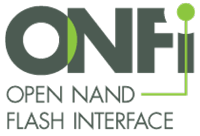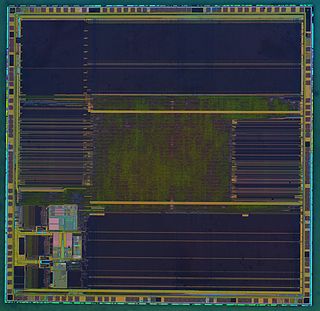The SATURN Development Group was an important industry forum that enabled the specification of chip-to-chip interfaces for the communications industry. It was co-founded in 1992 by PMC-Sierra and Sun Microsystems. Several significant specifications were completed through its actions including PL-2, PL-3, and PL-4. Many important semiconductor devices were developed to these specifications. SATURN was also influential in the specification of the ATM Forum's physical layer "UTOPIA" standards.

PMC-Sierra was a global fabless semiconductor company with offices worldwide that developed and sold semiconductor devices into the storage, communications, optical networking, printing, and embedded computing marketplaces.

Sun Microsystems, Inc. was an American company that sold computers, computer components, software, and information technology services and created the Java programming language, the Solaris operating system, ZFS, the Network File System (NFS), and SPARC. Sun contributed significantly to the evolution of several key computing technologies, among them Unix, RISC processors, thin client computing, and virtualized computing. Sun was founded on February 24, 1982. At its height, the Sun headquarters were in Santa Clara, California, on the former west campus of the Agnews Developmental Center.
PL-3 or POS-PHY Level 3 is a network protocol. It is the name of the interface that the Optical Internetworking Forum's SPI-3 Interoperability Agreement is based on. It was proposed by PMC-Sierra to the Optical Internetworking Forum and adopted in June 2000. The name means Packet Over SONET Physical layer level 3. PL-3 was developed by PMC-Sierra in conjunction with the SATURN Development Group.
Initial members included SynOptics and Interphase. The first meeting was held in April 1992. By August 1993, the SATURN group had 28 members.
SynOptics Communications was a Santa Clara, California-based early computer network equipment vendor from 1985 until 1994. SynOptics popularized the concept of the modular Ethernet hub and high-speed Ethernet networking over copper twisted-pair and fiber optic cables.

Interphase is the phase of the cell cycle in which a typical cell spends most of its life. During this phase, the cell copies its DNA in preparation for mitosis. Interphase is the 'daily living' or metabolic phase of the cell, in which the cell obtains nutrients and metabolizes them, grows, reads its DNA, and conducts other "normal" cell functions. The majority of eukaryotic cells spend most of their time in interphase. This phase was formerly called the resting phase. However, interphase does not describe a cell that is merely resting; rather, the cell is living, and preparing for later cell division, so the name was changed. A common misconception is that interphase is the first stage of mitosis. However, since mitosis is the division of the nucleus, prophase is actually the first stage.
After the formation of the Optical Internetworking Forum (OIF), two of the SATURN group's interfaces were successfully adopted by OIF. The PL-3 specification became SPI-3 and the PL-4 specification became SPI-4.2. The existence of the OIF also eliminated the need for the SATURN Development Group, and it was wound down around 2002.
The Optical Internetworking Forum (OIF) is a prominent non-profit consortium that was founded in 1998. It promotes the development and deployment of interoperable computer networking products and services through implementation agreements (IAs) for optical networking products and component technologies including SerDes devices.
SPI-3 or System Packet Interface Level 3 is the name of a chip-to-chip, channelized, packet interface widely used in high-speed communications devices. It was proposed by PMC-Sierra based on their PL-3 interface to the Optical Internetworking Forum and adopted in June 2000. PL-3 was developed by PMC-Sierra in conjunction with the SATURN Development Group.
PL-4 or POS-PHY Level 4 was the name of the interface that the interface SPI-4.2 is based on. It was proposed by PMC-Sierra to the Optical Internetworking Forum. The name means Packet Over SONET Physical layer level 4. PL-4 was developed by PMC-Sierra in conjunction with the Saturn Development Group.
The Open Group is an industry consortium that seeks to "enable the achievement of business objectives" by developing "open, vendor-neutral technology standards and certifications". It has over 625 members and provides a number of services, including strategy, management, innovation and research, standards, certification, and test development. It was established in 1996 when X/Open merged with the Open Software Foundation.
In computing, the Windows Sockets API (WSA), later shortened to Winsock, is a technical specification that defines how Windows network software should access network services, especially TCP/IP. It defines a standard interface between a Windows TCP/IP client application and the underlying TCP/IP protocol stack. The nomenclature is based on the Berkeley sockets API model used in BSD for communications between programs.
The Serial Peripheral Interface (SPI) is a synchronous serial communication interface specification used for short distance communication, primarily in embedded systems. The interface was developed by Motorola in the mid 1980s and has become a de facto standard. Typical applications include Secure Digital cards and liquid crystal displays.
Packet over SONET/SDH, abbreviated POS, is a communications protocol for transmitting packets in the form of the Point to Point Protocol (PPP) over SDH or SONET, which are both standard protocols for communicating digital information using lasers or light emitting diodes (LEDs) over optical fibre at high line rates. POS is defined by RFC 2615 as PPP over SONET/SDH. PPP is the Point to Point Protocol that was designed as a standard method of communicating over point-to-point links. Since SONET/SDH uses point-to-point circuits, PPP is well suited for use over these links. Scrambling is performed during insertion of the PPP packets into the SONET/SDH frame to solve various security attacks including denial-of-service attacks and the imitation of SONET/SDH alarms. This modification was justified as cost-effective because the scrambling algorithm was already used by the standard used to transport ATM cells over SONET/SDH. However, scrambling can optionally be disabled to allow a node to be compatible with another node that uses the now obsoleted RFC 1619 version of Packet over SONET/SDH which lacks the scrambler.
The Network Processing Forum (NPF) is an industry forum that was organized to facilitate and accelerate the development of next-generation networking and telecommunications products based on network processing technologies. The NPF was merged into the Optical Internetworking Forum in June 2006. The NPF produces Hardware, Software, and Benchmark Interoperability Agreements. These agreements enable equipment manufacturers to lower their time to market and development cost by enabling a robust, multi-vendor ecosystem. It also lowers the total cost of ownership of systems based on their interoperability agreements by enabling investments in test and verification infrastructure as well as enabling competition.
The System Packet Interface (SPI) family of Interoperability Agreements from the Optical Internetworking Forum specify chip-to-chip, channelized, packet interfaces commonly used in synchronous optical networking and Ethernet applications. A typical application of such a packet level interface is between a framer or a MAC and a network processor. Another application of this interface might be between a packet processor ASIC and a traffic manager device.
SPI-4.2 is a version of the System Packet Interface published by the Optical Internetworking Forum. It was designed to be used in systems that support OC-192 SONET interfaces and is sometimes used in 10 Gigabit Ethernet based systems.
The ARM Advanced Microcontroller Bus Architecture (AMBA) is an open-standard, on-chip interconnect specification for the connection and management of functional blocks in system-on-a-chip (SoC) designs. It facilitates development of multi-processor designs with large numbers of controllers and peripherals with a bus architecture. Since its inception, the scope of AMBA has, despite its name, gone far beyond microcontroller devices. Today, AMBA is widely used on a range of ASIC and SoC parts including applications processors used in modern portable mobile devices like smartphones. AMBA is a registered trademark of ARM Ltd.

The Open NAND Flash Interface Working Group, is a consortium of technology companies working to develop open standards for NAND flash memory and devices that communicate with them. The formation of ONFI was announced at the Intel Developer Forum in March 2006.
MIPI Alliance is a global, open membership organization that develops interface specifications for the mobile ecosystem including mobile-influenced industries. It was founded in 2003 by ARM, Intel, Nokia, Samsung, STMicroelectronics and Texas Instruments.

The Small Form Factor Special Interest Group or SFF-SIG is an international non-profit standards body focused on modular computer hardware technologies used in embedded and small form factor computers and controllers. Members are mainly computer board and component manufacturers.

UniPro is a high-speed interface technology for interconnecting integrated circuits in mobile and mobile-influenced electronics. The various versions of the UniPro protocol are created within the MIPI Alliance, an organization that defines specifications targeting mobile and mobile-influenced applications.
Terabit Ethernet or TbE is used to describe speeds of Ethernet above 100 Gbit/s. 400 Gigabit Ethernet and 200 Gigabit Ethernet standards developed by the IEEE P802.3bs Task Force using broadly similar technology to 100 Gigabit Ethernet were approved on December 6, 2017. In 2016, several networking equipment suppliers were already offering proprietary solutions for 200G and 400G.

STM32 is a family of 32-bit microcontroller integrated circuits by STMicroelectronics. The STM32 chips are grouped into related series that are based around the same 32-bit ARM processor core, such as the Cortex-M7F, Cortex-M4F, Cortex-M3, Cortex-M0+, or Cortex-M0. Internally, each microcontroller consists of the processor core, static RAM, flash memory, debugging interface, and various peripherals.
The Common Electrical I/O (CEI) refers to a series of influential Interoperability Agreements (IAs) that have been published by the Optical Internetworking Forum (OIF). CEI defines the electrical and jitter requirements for 3.125, 6, 11, 25-28, and 56 Gbit/s electrical interfaces.
Optical module refers to a typically hot-pluggable optical transceiver used in high-bandwidth data communications applications. Optical modules typically have an electrical interface on the side that connects to the inside of the system and an optical interface on the side that connects to the outside world through a fiber optic cable. The form factor and electrical interface are often specified by an interested group using a multi-source agreement (MSA). Optical modules can either plug into a front panel socket or an on-board socket. Sometimes the optical module is replaced by an electrical interface module that implements either an active or passive electrical connection to the outside world. A large industry supports the manufacturing and use of optical modules.






